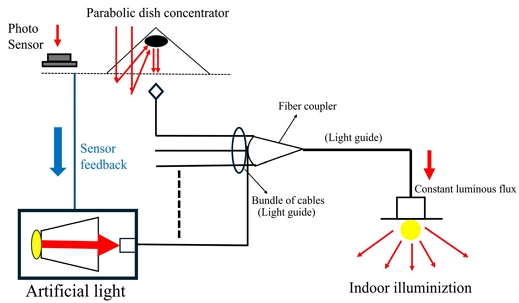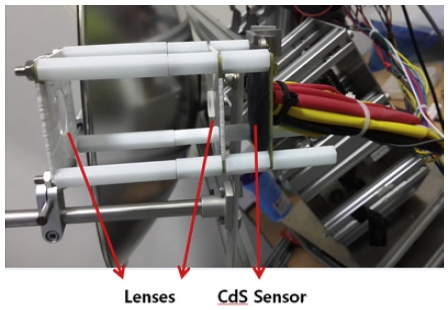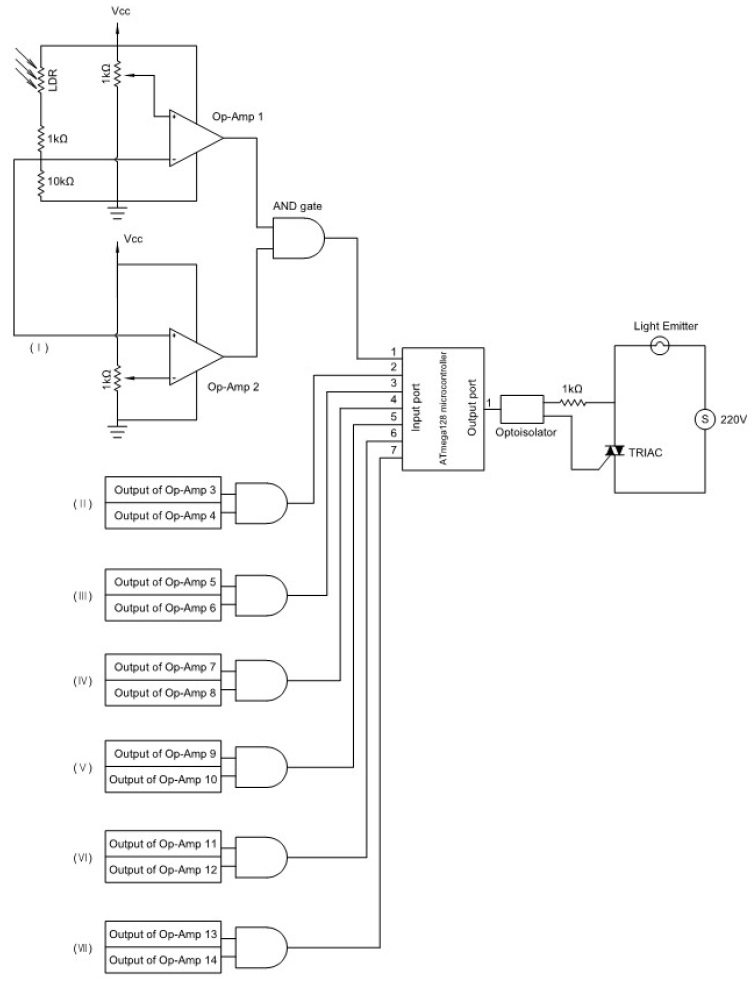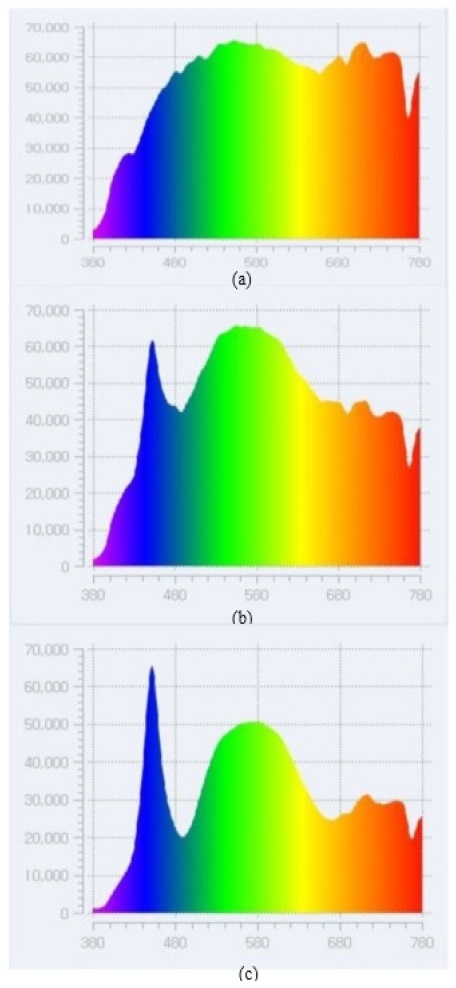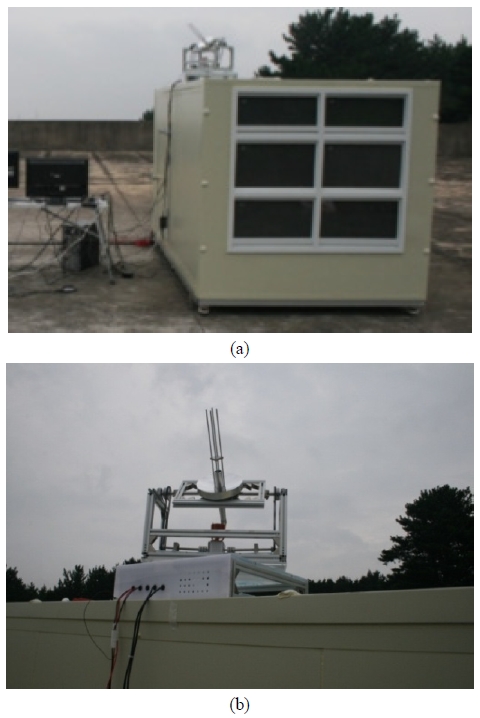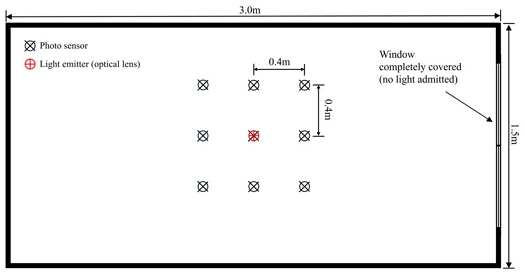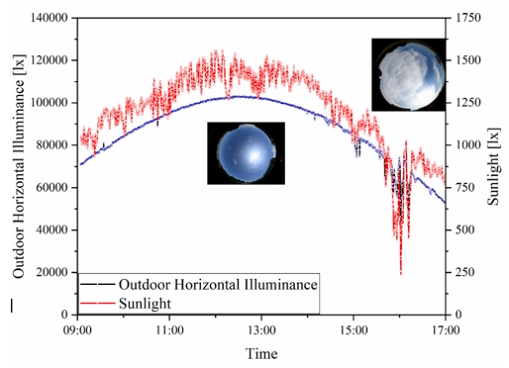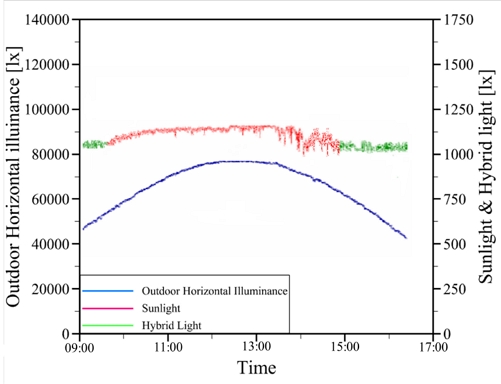
Optical Characteristics and Applicability of a Fiber-optic Hybrid Daylighting System Exploiting Sunlight and Artificial Light
ⓒ 2024. KIEAE all rights reserved.
Abstract
Using sunlight and artificial light for illuminating indoor spaces (dimlit areas) was studied by operating a fiber-optic hybrid daylighting system capable of delivering constant flux of visible light streams, which enables the implementation of constant lighting despite the variation in sunlight during daytime.
The system adds artificial light to a stream of sunlight when there is deficiency in sunlight to meet the target illuminance according to the feedback signal generated by the photo-sensor based control strategy developed in this work. The photometric characteristics of the mixed stream of sunlight and artificial light were analyzed and the applicability of the system was tested under actual operating conditions. Spectrum variations of light were measured and analyzed to investigate the validity of light mixing, i.e., hybrid daylighting. Besides its photometry, the control of illuminance in hybrid daylighting was explored by using a test cell on a clear and a partly cloudy day.
Results are presented in terms of photometric properties including spectral radiance and illuminance measured as appropriate. The mixing (adding) of artificial light to meet the target illuminance was quite successful and the illuminance remained close to the desired value within an allowable tolerance of ±3.5%.
Keywords:
Hybrid Daylighting, Optical Characteristics, Applicability, Performance Analysis키워드:
하이브리드 자연채광, 광학적 특성, 적용성, 성능 분석1. Introduction
When designing a healthy and energy-efficient lighting environment, one should bear in mind that most people tend to appreciate daylight in buildings as they provide irreplaeable natural elements (warmth, comfort, healthy atmosphere etc.).
Introduction of daylight into buildings generally improves productivity in performing a task by alerting and boosting occupant's natural circadian rhythm along with offering a pleasant working atmosphere. It is essential for designers, engineers and others involved in a building design and contruction to admit daylight as much as possible deeply into the interior of a building provided that its photometric properties (illuminance, glare etc.) are within the acceptable range of vision for occupants [1, 2].
Daylighting design is very important as it can contribute enormously to save energy and establish a healthy visual environment. It also can resolve the problems due to power shortage by avoiding the hours of peak electrical demand when various industrial and commercial activities are taking place. Also, it is widely practiced in most of the countries around the globe to penalize those consumers (building owners etc.) who use electricty during the peak hours. Especially, significantly higher rates are imposed if one exceeds the allowable maximum load set by utility companies. This trend is becoming more and more systematically practiced with the advent of climate change, which has caused catastrophical damage never experienced before in all parts of the globe [3].
Extensive studies have been carried out to develop daylighting systems for energy efficient buildings, which promote the quality of indoor environment, especially, from the perspective of indoor visual field of occupants. Although, daylighting systems tend to offer an affordable and attractive option in reducing the peak demand in energy use, depending on climates, they often cause undesirable effect such as increase in the cooling load by solar heat gains due to uncontrolled daylighting. In certain cases, it is important to optimally balance the use of electric lighting and space cooling at the same time [4].
Different forms of passive and active systems have been studied to exploit daylight in buildings to a greater extent. Of these, the systems with active daylighting schemes generally offer more efficient ways to introduce daylight in buildings as compared to those based on passive strategies. A fiber-optic daylighting system is one of those which constantly tracks the sun and capture and channel in the solar rays into a building for the establishment of better and natural visual environment. There have been many studies concerning the performance and applicability of a fiber-optic daylighting system, especially, its under various conditions. Most of the studies have concentrated their research focus on two issues, one with the high-precision operation of solar concentrators (such as, dish concentrators, Fresnel lens, etc.) and the other with the means to transmit sunlight into the target area as desired [5–10].
One of the most well-known and widely practiced active daylighting systems involves the use of daylight–responsive controls (lighting controls) in accordance with the available daylight. The feedback from a photo sensor checking the availability of daylight (sunlight) regulates the output of artificial light (electric lamp) to deliver an adequate amount of light for the target area. This system, however, suffers from the fluctuation of illuminance and brightness (glare) as two different types of luminaires (installed on a ceiling or wall) are used in its operation [11, 12].
That is, maintaining a constant illumination level or luminance at some reference plane (or point in a room) is often very difficult or even impossible as daylight (sunlight) varies continuously causing variation in illuminances as compared to the constant illumination by artificial light (by electric lamps).
To cope with this problem, this work has been carried out to eventually develop an active daylighting system capable of delivering a constant flux of light in illuminating an indoor area despite the variation in sunlight during daytime. Different from above where two separate light sources are individually operated to illuminate a target area sending two distinct streams of light, the presented hybrid daylighting system involves only one stream of light channeling into a room through an optical fiber cable and subsequently discharged via a terminal device (optical lens) to illuminate the target area in a room.
That is, the system can be considered as a “hybrid (active) daylighting system" capable of delivering only one stream of light which is a mixture of sunlight and artificial light as appropriate. No appreciable variation in the illuminance at the targeted area can be perceived by the human eye, which is also the major objective of this work making the fundamental difference as compared to existing active daylighting systems.
2. System Configuration
The presented hybrid daylighting consists of three major components: a parabolic dish concentrator mounted on a dual axis solar tracker, photo-sensor based control unit for the operation of artificial light source(an electric lamp), and light guides (optical fiber cables).
Fig. 1. shows the schematic of system configuration where sunlight is mingled with artificial (electric) light forming a light stream of constant luminous flux for indoor illumination. A parabolic dish concentrator mounted on a dual axis solar tracker collects the sunlight and transmit it through optical fiber cables, whereas artificial lamps are used to add light into the stream of sunlight as needed. A constant luminous flux of light (mixed light) is maintained before it is discharged through a luminaire (luminaires) installed on the ceiling or wall of an illuminated space.
The amount of the artificial light added to the sunlight is determined by a feedback signal from a photo-sensor based control strategy exploiting the conversion of light intensity to electric signals and subsequently into digital values, Fig. 2.
Fig. 3. schematically shows the control logic how the sunlight and artificial light are mixed together to form a stream of light of constant luminous flux. As shown, there were seven steps considered in adding artificial light to sunlight. A feedback control was developed based on the outdoor illuminance of 70,000–100,000 lx, which was constantly monitored by the photo sensor as shown in Fig. 2. The activation of artificial source (light emitter) was capable of boosting the luminous flux from 100 lux to 600 lux at an increment of 100 lux.
3. Test and Measurements
3.1. Photometric Measurement of Light Emitters (Optical Lenses)
The photometry of light streaming down through a terminal device on the ceiling shows different characteristics depending on the type of an emitter (optical lenses, etc.) used for the terminal device, the mixed ratio of sunlight and artificial light, and the types of artificial light source (electric lamp).
This is important as there is quite a difference in the illuminated area depending the types of emitter used, which can be treated as a point light source. The inherent optical characteristics of an emitter make the difference in the light spreading profile, which results in the difference in the effective illuminated area by the system. The photometric data obtained were very useful as the main focus of this work was to implement a stream of light with constant luminous flux for stable spot lighting.
As for the terminal device, five different types of light emitters (optical lenses, light rod) were analyzed for its light spreading characteristics. Of these, the widest spreading angle was displayed by the semi-concave lens, followed by concave, convex and semi-convex lenses. It, however, appears to be more suitable for spot lighting illuminating a rather small target area (task plane). To illuminate larger area more uniformly, a cylindrical shape light emitter performs better as it is capable of spreading light in all directions like a fluorescent lamp.
Fig. 4. shows luminous intensity distribution (lowest 10%) of five different types of light emitters measured by a goniphotometer (Optical & Photometric Technology Pty Ltd.). As aforementioned, even among the optical lenses, there is a difference in the light spreading angle from an optical lens to another, which can be easily identified by comparing the distribution curve displaying how the light is distributed from a luminaire.
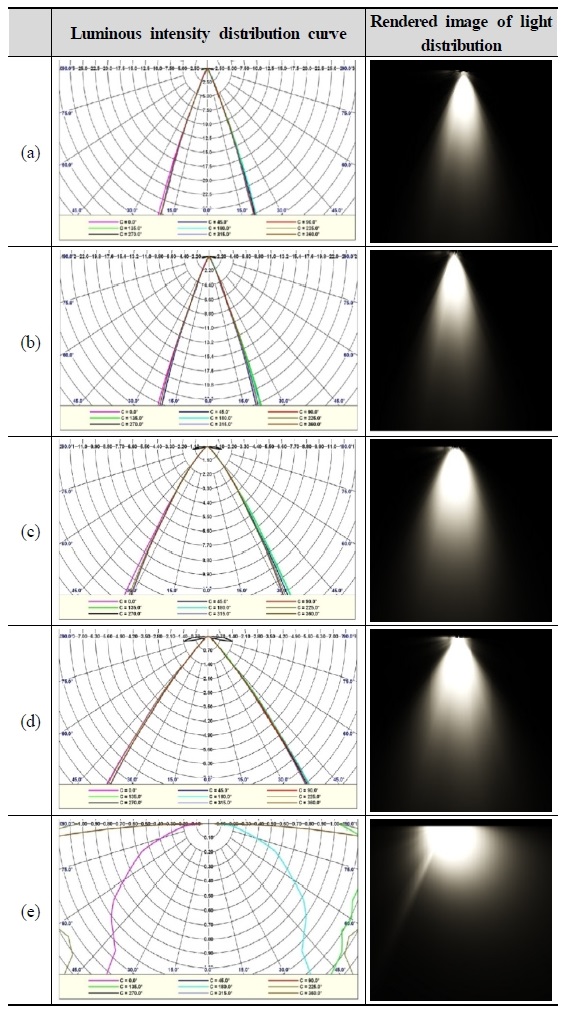
Luminous intensity distribution (lowest 10%) of different types of light emitters: (a) convex lens, (b) semi-convex lens, (c) concave lens, (d) semi-concave lens, (e) cylindrical rod
By comparing the intensity distribution curve of a cylinderical rod with optical lenses, it can be readily seen how effective the cylinderical rod is able to deliver light more widely and uniformly over any optical lenses.
3.2. Spectral Radiance
The spectral radiance of light emerging from a light emitter (an optical lens:32mm convex, 27.51mm in radius) is meaured by using a spectrometer (PR-650 Spectracolorimeter) under a clear sky condition. The measurement is quite important as it carries the crucial information about the light sources concerning their optical characteristics over a specific portion of the electromagnetic spectrum. That is, it gives the spectral distribution of light emerging from the emitter installed in an illuminated space (room) as a light source.
Fig. 5. shows the spectral radiance measurements for sunlight, mixed light (50% sunlight and 50% artificial light) and artificial light. Here the artifical light refers to that from a LED source whose color temperature is 3,000K. As shown, the spectral radiance of the mixed light displays a pattern of spectral radiance combining the characteristics of each constituent light source.
3.3. Operation of the Hybrid Daylighting System
To explore the applicability and actual performance of a hybrid daylighting system, a test cell built with prefabricated sandwich panels (location: 33.45oN, 126.6oE) has been used whose respective length, width, and height were 3.0m, 1.5m and 1.5m. The system hired a parabolic dish concentrator (0.3m in diameter) for sunlight (daylight) collection and a LED lamp (120W) for artificial light mixing, if needed. Fig. 6 shows the test cell used in a series of experiments performed in this work in conjunction with the operation of the hybrid daylighting system installed on its rooftop. All the windows and openings were completely covered to assure no light penetration except that from the daylighting system.
As shown in Fig. 7., nine photo cells were placed 0.3m high from the floor at intervals of 0.4m. The grid layout was determined considering the light spreading angle of the optical lens in diffusing light as aforementioned in Fig. 4. in conjunction with the goniophotometer measurements. Especially, the main focus was on the illuminance (instantaneous illuminance) values measured at the point and its vicinity directly below the semi-convex lens (refer to Fig. 4. (b) for its light distribution characteristics) installed in the ceiling diffusing light transmitted by an optical fiber cable. That is, the photo-sensors were arranged for the case when the hybrid daylighting system is hired to mainly illuminate the area directly below the emitter on top (spot lighting).
To verify the applicability of the present daylighting system, test measurements were conducted in October and November. As time ellapses, the air mass changes with solar altitude which will result in the difference in illuminance even at the same time of the day. Fig. 8. shows the time variation of illuminance on a clear day in October measured by the photo sensor directly below the light diffuser from 9:00 a.m. to 5:00 p.m. without any addition of artificial light. In comparison, Fig. 9. presents a case where the artificial light is mixed with sunlight during the hours of sunlight deficiency to meet the preset target illuminance of 1,250 lux. The target value was set in view of the light emanating from the diffuser was mostly greater than 1,250 lux (measured at the point directly below the light diffuser) during sunshine hours in the previous day (Fig. 8.). As shown in these figures, the test measurements were conducted in two consecutive days of clear skies where no appreciable difference was identified in the time variation of outdoor horizontal illuminance except short duration in the afternoon (around 3 p.m. and 4 p.m. due to cloud movements). This can be easily seen by comparing the outdoor horizontal illuminance in Figs 8. and 9., respectively.
In Fig. 8., the illuminance measured by the photo sensor generally undershoots the target illuminance in the morning from 9 a.m. to 10 a.m. and in the afternoon from 3 p.m. to 5 p.m., due to large air mass (AM) and cloud covers (especially, in the afternoon). Meanwhile, as shown in Fig. 9., the target illuminance is satisfied throughout the hours of the test run due to the operation of the hybrid daylighting system in such a manner to make up for a deficiency in the illuminance which is directed by the feedback signal to meet the target illuminance (Fig. 1.).
Fig. 10. also shows the measurement of illumince throughout a clear day in November from 9 a.m. to 4:30 p.m. In this case, however, the outdoor horizontal illuminance was lower throughout the hours of measurement than the cases mentioned above due to lower solar altitude in November as compared to that in October.
The maximum outdoor horizontal illuminance was less than 80,000 lux whereas it marked near 100,000 lux as shown in Figs. 8. and 9. Fig. 10., however, clearly demonstrates the effectiveness of the present hybrid daylighting system in achieving and maintaining the target illuminance (1,100 lux) during the hours of insufficient sunlight: first 30 minutes of the measurement in the morning and late in the afternoon (from 3 p.m. to 4:30 p.m.). The target illuminance reflects the strength of solar insolation, which is directly related to the photo sensor readings just below the light diffuser without the addition of artificial light. The use of an artificial source (LED lamp) with slightly larger capacity (> 120W) could have been better in facilitating the achievement of the target illuminance. Althougly close, the addition of artificial light was a bit short of fully satisfying the preset target illuminance of 1,100 lux in the late afternoon sunshine hours.
4. Conclusions
A study has been performed to explore the photometry and the applicability of a hybrid daylighting system based on fiber optics in conjuction with the combined use of sunlight from a parabolic dish concentrator and light from artificial sources (LED lamp, etc.). The system introduced in this work can promote the use of active daylighting system in conjunction with artificial (electric) lighting system, where the latter allows stable operation of the daylighting system under various sky conditions.
The artificial light was generated from a 120W LED lamp with color temperature of 3,000K. It was observed that the mixed light displays a pattern of spectral radiance combining the characteristics of each constituent light source.
The potential of its applicability and reliability of the hybrid daylighting system has been identified by actual on-site measurements using a test cell. Results indicate that the system could be effectively applied for illuminating a specified area (spot lighting) in a stable manner without undue difficulties.
The system, however, needs some improvement and further studies are required concerning the application of different types of light emitters (other than the optical lenses), applicable light source since they generate different profiles in distributing light (as shown in Fig. 4.). In addition, the accurate and robust feedback control is very important in applying the system under various operating conditions, which assures its reliability and practicality in harnessing the sun's energy for indoor lighting more aggressively.
Acknowledgments
This research was supported by the Basic Science Research Program through the National Reꠓsearch Foundation of Korea (NRF) funded by the Ministry of Education (Grant no. 2021R1I1A1A01060291) and by the Renewable Surplus Sector Coupling Technology Program of the Korea Institute of Energy Technology Evaluation and Planning (KETEP) granted financial resource from the Ministry of Trade, Industry & Energy, Republic of Korea (No. 202262100050).
References
-
A. Allouhi et al., Energy consumption and efficiency in buildings: Current status and future trend, Journal of Cleaner Production, 109(16), 2015.12, pp.118-130.
[https://doi.org/10.1016/j.jclepro.2015.05.139]

-
P.M. Bluyssen, M. Aries, P. van Dommelen, Comfort of workers in office buildings: The European HOPE project, Building and Environment, 46(1), 2011.01, pp.280-288.
[https://doi.org/10.1016/j.buildenv.2010.07.024]

-
C.Z. Li et al., Advances in the research of building energy saving, Energy and Buildings, 254, 2022.01, 111556.
[https://doi.org/10.1016/j.enbuild.2021.111556]

-
D.H.W. Li, E.K.W. Tsang, An analysis of daylighting performance for office buildings in Hong Kong, Building and Environment, 43, 2008.09, pp.1446-1458.
[https://doi.org/10.1016/j.buildenv.2007.07.002]

-
L. Bellia, F. Bisegna, G. Spada, Lighting in indoor environments: Visual and nonvisual effects of light sources with different spectral power distributions, Building and Environment 46(10), 2011.10, pp.1984-1992.
[https://doi.org/10.1016/j.buildenv.2011.04.007]

-
H.J. Han et al., Fiber optic solar lighting: Functional competitiveness and potential, Solar Energy, 94, 2013.08, pp.86-101.
[https://doi.org/10.1016/j.solener.2013.04.010]

-
S. Dutton, L. Shao, Raytracing simulation for predicting light pipe transmittance, International Journal of Low Carbon Technologies, 2(4), 2007.10, pp.339-358.
[https://doi.org/10.1093/ijlct/2.4.339]

-
J. Song et al., A high precision tracking system based on a hybrid strategy designed for concentrated sunlight transmission via fibers, Renewable Energy, 57, 2013.09, pp.12-19.
[https://doi.org/10.1016/j.renene.2013.01.022]

-
C. Wang, H. Abdul-Rahman, S.P. Rao, Daylighting can be fluorescent: Development of a fiber solar concentrator and test for its indoor illumination, Energy and Buildings, 42(5), 2010.05, pp.717-727.
[https://doi.org/10.1016/j.enbuild.2009.11.011]

-
R. Ahmed et al., Computer vision and photosensor based hybrid control strategy for a two-axis solar tracker - Daylighting application, Solar Energy, 224, 2021.08, pp.175-183.
[https://doi.org/10.1016/j.solener.2021.05.077]

- N. Ruck et al., Daylight in buildings: A source book on daylighting systems and components, International Energy Agency, 2000.
-
K.R. Wagiman et al., T. Kwang, Lighting system control techniques in commercial buildings: Current trends and future directions, Journal of Building Engineering, 31, 2020.09, 101342.
[https://doi.org/10.1016/j.jobe.2020.101342]

